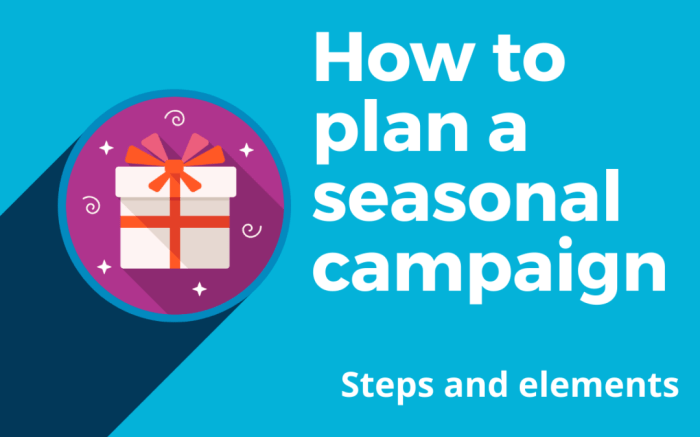Creating Seasonal Content Marketing Plans sets the stage for dynamic brand storytelling, offering a roadmap to captivate audiences through strategic content tailored to seasonal trends. From researching to measuring performance, this guide dives deep into the art of crafting compelling marketing campaigns that resonate with consumers year-round.
Researching Seasonal Trends
Researching seasonal trends is crucial for content marketing as it helps businesses stay relevant and engaging with their target audience. By understanding what trends are popular during specific seasons, companies can tailor their content to meet the needs and interests of their customers, ultimately driving more traffic and engagement.
Importance of Researching Seasonal Trends
- Allows businesses to create timely and relevant content
- Helps in planning marketing campaigns effectively
- Increases engagement and conversions by aligning content with seasonal interests
Tools and Resources for Identifying Seasonal Trends
- Google Trends: Offers insights into search trends based on specific s
- Social Media Analytics: Platforms like Facebook and Twitter provide data on trending topics and hashtags
- Industry Reports: Reports from reputable sources can offer valuable insights into seasonal trends within specific industries
Analyzing Data to Predict Upcoming Seasonal Trends
- Look at past data: Analyze previous seasonal trends to identify patterns and predict future trends
- Monitor social media: Keep an eye on social media platforms to spot emerging trends and topics
- Engage with your audience: Interact with your customers to understand their preferences and interests for upcoming seasons
Developing Seasonal Content Calendar

Creating a seasonal content calendar is essential for staying organized and relevant throughout the year. It involves planning and scheduling content that aligns with different seasons, holidays, and trends to maximize engagement and reach.
Aligning Content with Seasons and Holidays
To align content with seasons and holidays, start by researching upcoming trends and events for each month. Consider how your brand can tie in relevant topics to connect with your audience during specific times of the year. Whether it’s creating themed content for holidays like Halloween or summer-themed promotions, ensure your content is timely and resonates with your target audience.
- Identify key dates: Highlight important dates and holidays that are relevant to your industry or target audience.
- Create themed content: Develop content ideas that align with the season or holiday to capture your audience’s attention.
- Utilize seasonal trends: Incorporate current trends and topics that are popular during specific seasons to stay relevant and engaging.
Organizing and Scheduling Seasonal Content
Organizing and scheduling seasonal content effectively requires a strategic approach to ensure consistency and quality throughout the year. Use a content calendar to plan out your content in advance, allowing for adjustments and flexibility as needed.
- Set clear goals: Define your content objectives and key performance indicators (KPIs) for each season to measure success.
- Establish a content calendar: Create a detailed calendar outlining content themes, topics, and publishing dates to stay on track.
- Collaborate with team members: Involve your team in the content planning process to brainstorm ideas and ensure a cohesive strategy.
- Monitor and analyze performance: Regularly review your content’s performance metrics to identify what’s working and make improvements for future seasons.
Tailoring Content for Different Seasons
Tailoring content for different seasons is crucial for brands to stay relevant and engage with their target audience effectively. By adjusting the messaging, visuals, and overall tone of their content, brands can create a more personalized and relatable experience for consumers based on the specific season.
Examples of Successful Seasonal Content Adaptation
- Starbucks – Starbucks is known for adapting their menu and marketing campaigns to align with different seasons. For example, they introduce seasonal drinks like the Pumpkin Spice Latte in the fall and the Peppermint Mocha in the winter, creating excitement and anticipation among customers.
- Nike – Nike regularly launches seasonal collections that cater to the weather and activities associated with each season. Their winter collections focus on warmth and durability, while their summer collections prioritize breathability and lightweight materials.
- Coca-Cola – Coca-Cola often changes the color scheme of their cans and bottles to match the season. For instance, they may release limited-edition packaging with holiday themes during the winter months, tapping into the festive spirit of the season.
Tips for Creating Engaging Seasonal Content, Creating Seasonal Content Marketing Plans
- Understand Your Audience: Tailor your content to resonate with the preferences and interests of your target audience during each season.
- Utilize Seasonal Themes: Incorporate seasonal elements, such as colors, motifs, and imagery, into your content to evoke the feelings and associations of that particular season.
- Create Seasonal Promotions: Offer special deals, discounts, or limited-time offers that are relevant to the season to attract and retain customers.
- Stay Consistent Across Channels: Ensure that your seasonal content is cohesive across all marketing channels to maintain brand identity and messaging consistency.
Leveraging Seasonal Campaigns

Seasonal campaigns can greatly benefit a brand’s marketing strategy by tapping into the natural ebbs and flows of consumer behavior throughout the year. By aligning marketing efforts with specific seasons, holidays, or events, brands can create relevant and timely content that resonates with their target audience. This can result in increased engagement, brand awareness, and ultimately, sales.
Examples of Successful Seasonal Campaigns
- Starbucks’ Pumpkin Spice Latte campaign, which is eagerly anticipated every fall and has become a cultural phenomenon.
- Coca-Cola’s “Share a Coke” summer campaign, where personalized bottles with names and phrases boosted sales and engagement.
- Amazon’s Prime Day, a summer shopping event that has become a global phenomenon, driving sales and memberships.
Tips for Aligning Seasonal Campaigns with Marketing Goals
- Understand your target audience’s seasonal behaviors and preferences to create relevant content.
- Set clear objectives for each seasonal campaign, whether it’s increasing brand awareness, driving sales, or boosting engagement.
- Integrate seasonal themes and messaging across all marketing channels to ensure consistency and maximum impact.
- Utilize data and analytics to track the performance of seasonal campaigns and optimize future strategies.
Measuring Seasonal Content Performance: Creating Seasonal Content Marketing Plans
When it comes to seasonal content marketing, measuring performance is crucial for understanding what works and what doesn’t. By analyzing key metrics, businesses can optimize future campaigns and maximize their impact.
Key Metrics to Track
- Engagement Metrics: Monitor metrics like click-through rates, time spent on page, social shares, and comments to gauge audience interaction with seasonal content.
- Conversion Rates: Track the number of leads or sales generated from seasonal campaigns to measure effectiveness in driving action.
- Traffic Sources: Analyze where the traffic is coming from to identify the most successful channels and optimize marketing efforts.
- ROI: Calculate the return on investment for seasonal campaigns to determine the overall profitability and success of the content strategy.
Analyzing Data for Optimization
It’s essential to analyze the data collected from seasonal content performance to make informed decisions and optimize future campaigns.
- Identify Trends: Look for patterns in the data to understand what resonates with your audience during different seasons.
- A/B Testing: Experiment with different content formats, messaging, and visuals to see what drives the best results and adjust strategies accordingly.
- Seasonal Comparison: Compare performance across different seasons to identify opportunities for improvement and capitalize on successful trends.
- Feedback Loop: Gather feedback from customers and analyze their responses to refine content strategies and ensure continued engagement.
